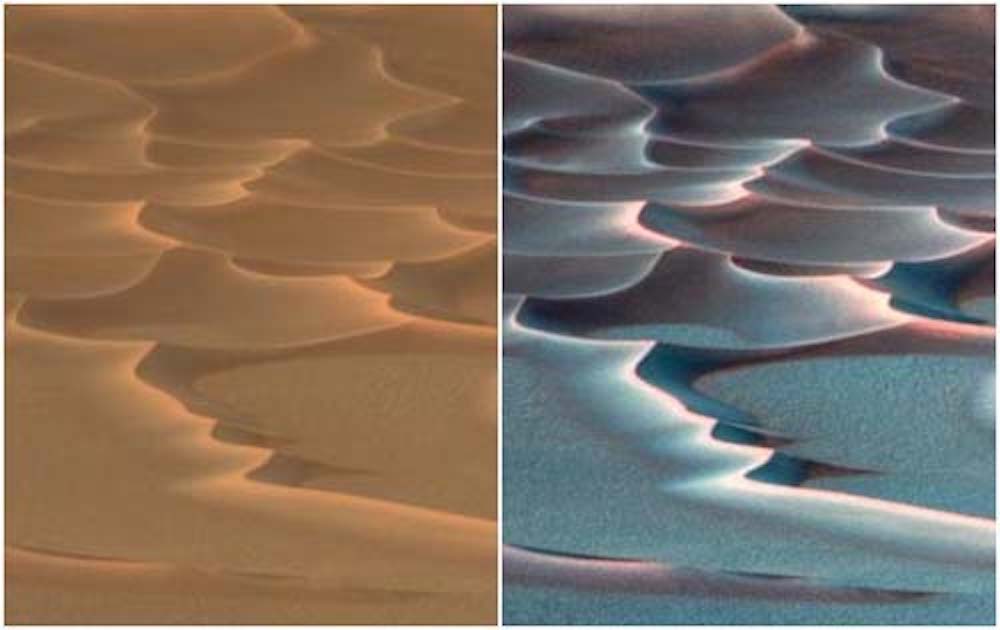Create a free profile to get unlimited access to exclusive videos, sweepstakes, and more!
Is Mars turning into Dune? Its megaripples sure look like Arrakis
Martian landforms known as megaripples were thought to be relics of a bygone era, but they continue to evolve.

The fictional planet of Arrakis was also known as Dune for a reason. Its endless alien deserts were both breathtaking and desolate — not unlike Mars.
Mars is rippling with dunes. While nothing that we know of lives there, like the cacti and cielagos of Arrakis, landforms known as megaripples were thought to be relics of a bygone era that had not moved in billions of years. Planetary Science Institute Research scientist Matthew Chojnacki, who led a study recently published in Journal of Geophysical Research: Planets, analyzed the megaripples and found them to be much more dynamic than that.
NASA’s HiRISE (High Resolution Imaging Science Experiment) aboard the Mars Reconnaissance orbiter showed that while Mars is freezing, it isn’t frozen in time. HiRISE images showed that the megaripples actually creep across the surface of Mars over time, and more of them can be found in the north polar region than anywhere else on the planet. Observations showed that the landscape would gradually change, since HiRISE can keep finding and imaging the same formations over and over. Further analysis by Chojnacki and his team also showed changes.
“It likely requires an abundance of mobile fine sand that hops along (called saltation) and impacts the megaripple particles, allowing them to move downwind along with other swifter bedforms,” he told SYFY WIRE. “This is supported by observations of isolated megaripples that appear static.”
It appears that Martian megaripples are made of coarser sand than its other ripples or dunes are. That means they would need more powerful winds to move, but the wind does affect the finer sand grains in smaller formations, which is why that sea of sand is mobilized enough by the wind to slowly take the megaripples with it. Chojnacki also used photogrammetry, an image processing technique that basically measures the objects in photographs. This gave him enough information to create topographical models of the megaripples to see how they migrate.
In addition to photogrammetry, orthrorectification allowed for the removal of effects of image perspective. With everything being shown for its actual size, distance would not give the illusion of something being larger than something else, and even the smallest changes in the landscape would show up when images from different time frames were compared. Megaripples are around 3-6 feet tall and anywhere from 15 to 120 feet apart, monstrous next to smaller ripples but nothing when you compare them to Martian dunes that tower hundreds to thousands of feet over them. There are some similarities between the deserts of Earth and Mars.
“Most of the giant sand dunes on Earth are too large to migrate as fast as megaripples,” Chojnacki said. "Megadunes are so large and host steep slopes that they have tons of potential energy for sand avalanches or other changes to occur, unlike much smaller megaripples.”
Megaripples don’t migrate that fast, but compared to a dune that could block a Harknonnen attack vessel, it may seem they do. Even nearly unnoticeable changes are enough to prove that Mars is (at least in some ways) a dynamic planet. Despite it being lifeless so far as we know, and even if it was always lifeless, its landscape and climate continue to change. There are some megaripples that stay where they are. It is possible that they are too heavy for the surrounding sand to carry them, depending on how much is there, or that winds are not strong enough.
“Many megaripples and similar bedforms on Mars are likely relic landforms and quite ancient,” said Chojnacki. “On the other hand, many megaripples are clearly mobile in the current climate and contributing to landscape evolution.”
So whether or not there are any extraterrestrial microbes out there, between creeping sands on its surface, Marsquakes, and volcanic rumbles in its depths, Mars is, at least geologically, alive.


























